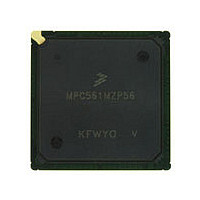MPC561MZP56 Freescale, MPC561MZP56 Datasheet - Page 797

MPC561MZP56
Manufacturer Part Number
MPC561MZP56
Description
Manufacturer
Freescale
Datasheet
1.MPC561MZP56.pdf
(1420 pages)
Specifications of MPC561MZP56
Cpu Family
MPC56x
Device Core
PowerPC
Device Core Size
32b
Frequency (max)
56MHz
Interface Type
QSPI/SCI/SPI/UART
Total Internal Ram Size
32KB
# I/os (max)
56
Number Of Timers - General Purpose
22
Operating Supply Voltage (typ)
2.6/5V
Operating Supply Voltage (max)
2.7/5.25V
Operating Supply Voltage (min)
2.5/4.75V
On-chip Adc
2(32-chx10-bit)
Instruction Set Architecture
RISC
Operating Temp Range
-40C to 125C
Operating Temperature Classification
Automotive
Mounting
Surface Mount
Pin Count
388
Package Type
BGA
Program Memory Type
ROMLess
Program Memory Size
Not Required
Lead Free Status / RoHS Status
Not Compliant
Available stocks
Company
Part Number
Manufacturer
Quantity
Price
Company:
Part Number:
MPC561MZP56
Manufacturer:
Freescale Semiconductor
Quantity:
10 000
Company:
Part Number:
MPC561MZP56R2
Manufacturer:
Freescale Semiconductor
Quantity:
10 000
- Current page: 797 of 1420
- Download datasheet (11Mb)
When an event occurs in a submodule that activates a flag line, the corresponding flag bit in the status
register is set. The status register is read/write, but a flag bit can be reset only if it has previously been read
as a one. Writing a “one” to a flag bit has no effect. When the software intends to clear only one flag bit
within a status register, the software must write an all-ones 16-bit value except for the bit position to be
cleared which is a zero.
The enable register is initialized by the software to indicate whether each interrupt request is enabled for
the levels defined in the ICS.
Each bit in the IRQ pending register is the result of a logical “AND” between the corresponding bits in the
status and in the enable registers. If a flag bit is set and the level enable bit is also set, then the IRQ pending
bit is set, and the information is transferred to the interrupt control section that is in charge of sending the
corresponding level to the CPU. The IRQ pending register is read only.
The submodule number of an interrupting source defines the corresponding MIRSM number and the bit
position in the status registers. To find the MIRSM number and bit position of an interrupting source,
proceed as follow:
17.12.3 MIRSM0 Interrupt Registers
17.12.3.1 Interrupt Status Register (MIOS14SR0)
This register contains the flag bits that are raised when the submodules generate an interrupt. Each bit
corresponds to a given submodule.
Freescale Semiconductor
1. Divide the interrupting submodule number by 16
2. The integer result of the division gives the MIRSM number
3. The reminder of the division gives the bit position
If a submodule in a group of 16 cannot generate interrupts, then its
corresponding flag bit in the status register is inactive and is read as zero.
In the case of multiple requests levels implementation in the same MIOS14,
it is possible to enable interrupts at more than one different levels for the
same submodule. It is the responsibility of the software to manage this.
When the enable bit is not set for a particular submodule, the corresponding
status register bit is still set when the corresponding flag is set. This allows
the traditional software approach of polling the flag bits to see which ones
are set. The status register makes flag polling easy, since up to 16 flag bits
are contained in one register.
MPC561/MPC563 Reference Manual, Rev. 1.2
NOTE
NOTE
NOTE
Modular Input/Output Subsystem (MIOS14)
17-65
Related parts for MPC561MZP56
Image
Part Number
Description
Manufacturer
Datasheet
Request
R

Part Number:
Description:
MPC5 1K0 5%
Manufacturer:
TE Connectivity
Datasheet:

Part Number:
Description:
MPC5 500R 5%
Manufacturer:
TE Connectivity
Datasheet:

Part Number:
Description:
MPC5 5K0 5%
Manufacturer:
Tyco Electronics
Datasheet:

Part Number:
Description:
MPC5 5R0 5%
Manufacturer:
Tyco Electronics
Datasheet:

Part Number:
Description:
MPC5 50K 5%
Manufacturer:
Tyco Electronics
Datasheet:

Part Number:
Description:
MPC5 1R0 5%
Manufacturer:
Tyco Electronics
Datasheet:

Part Number:
Description:
TOWER ELEVATOR BOARDS HARDWARE
Manufacturer:
Freescale Semiconductor
Datasheet:

Part Number:
Description:
TOWER SERIAL I/O HARDWARE
Manufacturer:
Freescale Semiconductor
Datasheet:

Part Number:
Description:
LCD MODULE FOR TWR SYSTEM
Manufacturer:
Freescale Semiconductor
Datasheet:

Part Number:
Description:
DAUGHTER LCD WVGA I.MX51
Manufacturer:
Freescale Semiconductor
Datasheet:

Part Number:
Description:
TOWER SYSTEM BOARD MPC5125
Manufacturer:
Freescale Semiconductor
Datasheet:












